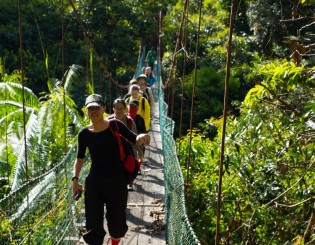What students achieve
 Students on the MRes Tropical Forest Ecology routinely contribute to active research programmes, and the training you receive means the project you conduct for your thesis should be should have value beyond obtaining your degree alone. For those interested in pursuing an academic career, the best outcome from your thesis is converting it into a publication – either as a standalone paper focussed on your thesis, or with your data and insights contributing to a bigger picture paper.
Students on the MRes Tropical Forest Ecology routinely contribute to active research programmes, and the training you receive means the project you conduct for your thesis should be should have value beyond obtaining your degree alone. For those interested in pursuing an academic career, the best outcome from your thesis is converting it into a publication – either as a standalone paper focussed on your thesis, or with your data and insights contributing to a bigger picture paper.
We make publishing as easy for you as we can: we give a lot of detailed feedback on your project plan, we have regular writing workshops to help you hone the final product, and we require you to submit your thesis in a format suitable for submission to an international journal. We know how important it is for students who want to go on in academia to get their work published, and thesis supervisors routinely provide support for students for several years after finishing the course to help them publish.
MRes Tropical Forest Ecology is a relatively new course, but we’re already seeing past students convert their theses into publications. A couple of examples are:
- Gray, R. E. J., R. M. Ewers, M. J. W. Boyle, A. Y. C. Chung, and R. J. Gill. 2018. Effect of tropical forest disturbance on the competitive interactions within a diverse ant community. Scientific Reports 8:5131.
- Osborne, O. G., R. De-Kayne, M. I. Bidartondo, I. Hutton, W. J. Baker, C. G. N. Turnbull, and V. Savolainen. 2018. Arbuscular mycorrhizal fungi promote coexistence and niche divergence of sympatric palm species on a remote oceanic island. New Phytologist 217:1254-1266.
Academic staff at Silwood Park Campus, where this course is hosted, have a long track record of helping students turn their theses into publications. Other examples of Silwood Masters student projects in tropical forest ecology that have been published include:
- Cusack, J. J., O. R. Wearn, H. Bernard, and R. M. Ewers. 2015. Influence of microhabitat structure and disturbance on detection of native and non-native murids in logged and unlogged forests of northern Borneo. Journal of Tropical Ecology 31:25-35.
- Ewers, R. M., M. J. W. Boyle, R. A. Gleave, N. S. Plowman, S. Benedick, H. Bernard, T. R. Bishop, E. Y. Bakhtiar, V. K. Chey, A. Y. C. Chung, R. G. Davies, D. P. Edwards, P. Eggleton, T. M. Fayle, S. R. Hardwick, R. Homathevi, R. L. Kitching, M. S. Khoo, S. H. Luke, J. J. March, R. Nilus, M. Pfeifer, S. V. Rao, A. C. Sharp, J. L. Snaddon, N. E. Stork, M. J. Struebig, O. R. Wearn, K. M. Yusah, and E. C. Turner. 2015. Logging cuts the functional importance of invertebrates in tropical rainforest. Nature Communications 6:6836.
- Loveridge, R., O. R. Wearn, M. Vieira, H. Bernard, and R. M. Ewers. 2016. Movement behavior of native and invasive small mammals shows logging may facilitate invasion in a tropical rain forest. Biotropica 48:373-380.
- Marsh, C. J., O. T. Lewis, I. Said, and R. M. Ewers. 2010. Community-level diversity modelling of birds and butterflies on Anjouan, Comoro Islands. Biological Conservation 143:1364-1374.
- Twining, J. P., H. Bernard, and R. M. Ewers. 2017. Increasing land-use intensity reverses the relative occupancy of two quadrupedal scavengers. PLoS ONE 12:e0177143.
- Wearn, O. R., D. C. Reuman, and R. M. Ewers. 2012. Extinction debt and windows of conservation opportunity in the Brazilian Amazon. Science 337:228-232.


